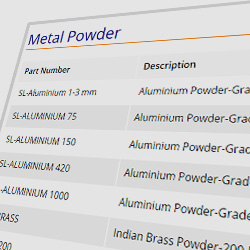Blog
Metal Powder Applications and Uses
May 4, 2017
 Metal powder applications exist in every industry. Naturally, there are the sintered products we’ve explored and will continue to investigate, but there are other disciplines where alloy powders rule. Perhaps we should study a few alternative powder applications, just so that the newfound knowledge lends our sintering work context, yes? Starting with resins and paints, here’s a look at some of these loose-grained applications.
Metal powder applications exist in every industry. Naturally, there are the sintered products we’ve explored and will continue to investigate, but there are other disciplines where alloy powders rule. Perhaps we should study a few alternative powder applications, just so that the newfound knowledge lends our sintering work context, yes? Starting with resins and paints, here’s a look at some of these loose-grained applications.
Powders and Paints
When a metal powder is added to paint, the applied metallic finish makes an object look like a solid casting. It’s durable and glossy, decorative and reflective, and the pigment will never fade. Additionally, this is a cost-effective solution. The object is gaining an aesthetically appealing metal finish, but it’s a cosmetic effect. Much though it looks otherwise, this is not a solid object, not some copper or bronze item with a huge price tag and an equally massive heft.
Additive Fabrication
A gas atomised metal powder, produced by directing a jet of inert gas towards a molten metal stream, and is used to form an ultrafine, talc-like mass. The tiny particles are perfect spheres when they’re viewed under a microscope, so it’s possible to create dense structures out of these small building blocks. Used as a rapid prototyping resource, it’s the 3D printing industry that packs these fine-grained particles together to build strong first-run products. After all, the additive manufacturing sector requires a prototype laminate structure that can closely emulate the material properties of the final product.
Soldering and Brazing
We’re getting closer to sintering now, with parts-fusing technology entering our discourse. This time, the metal powders are bonding agents. The finely ground or atomised particles are designed to bridge gaps between a heated workpiece surface and a heat source. At this point, the powder liquefies and fills any surface irregularities, cavities, and porous near-solids until a strong joint is formed. This mechanical usage area is mirrored by both the electrical and electronics field, the twin engineering disciplines that use electrically conducting materials to create metallic pastes, the compounds that augment the soldering process.
When contemplating metal powder applications and uses, it’s almost easier to list the places where the particles aren’t found. Employed in welding and soldering, paints and prototypes, and countless other essential usage domains, the fine-alloyed granules have worked their way into every industrial process. As for sintering applications, there are lubricant saturated powders that imbue plain bearings with friction-handling characteristics, but there are also sintered diamond cutting tools, products that blend the densely structured jewels with compressed metal powders to create powerful cutting tools.
Optimized by: Netwizard SEO

